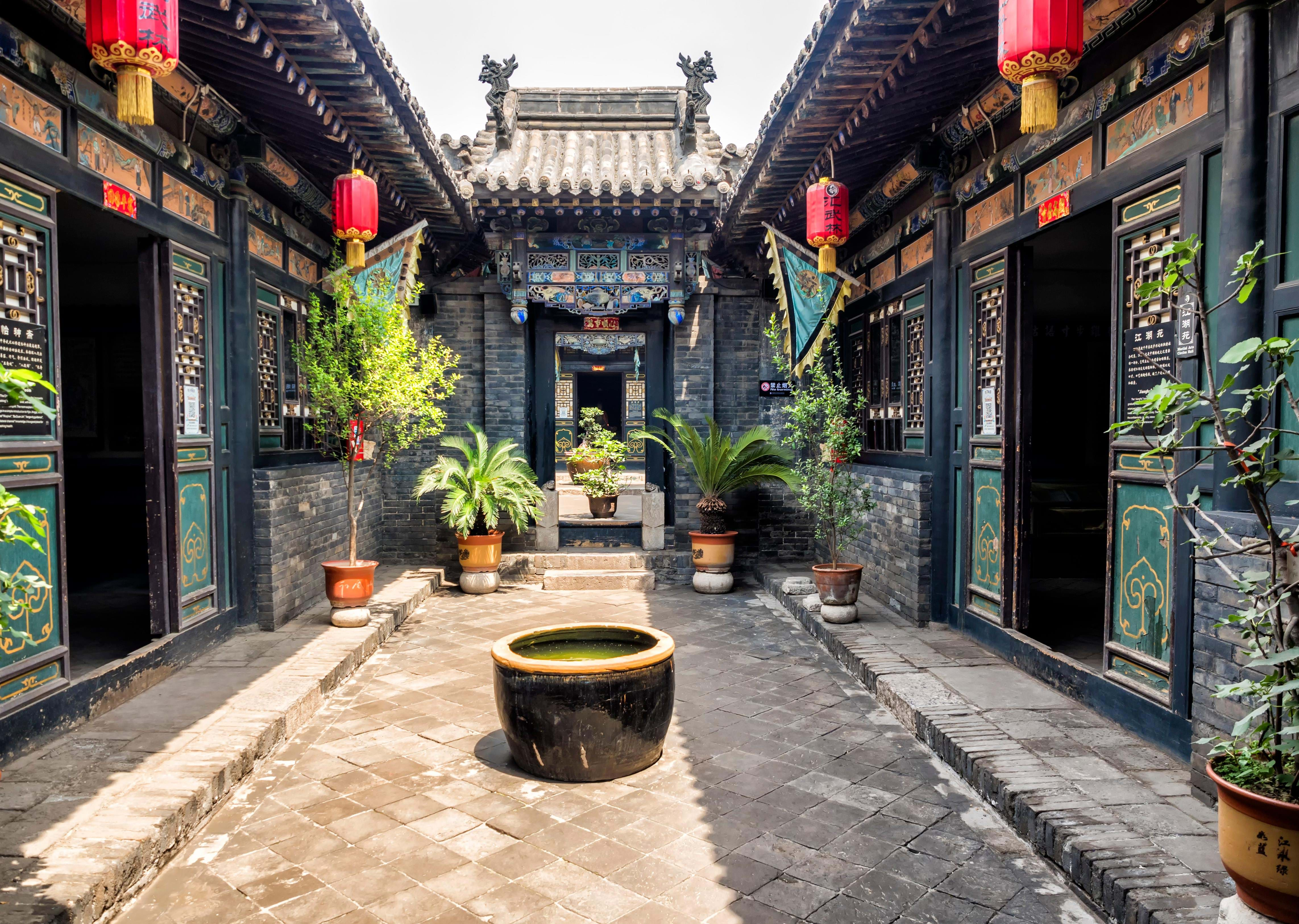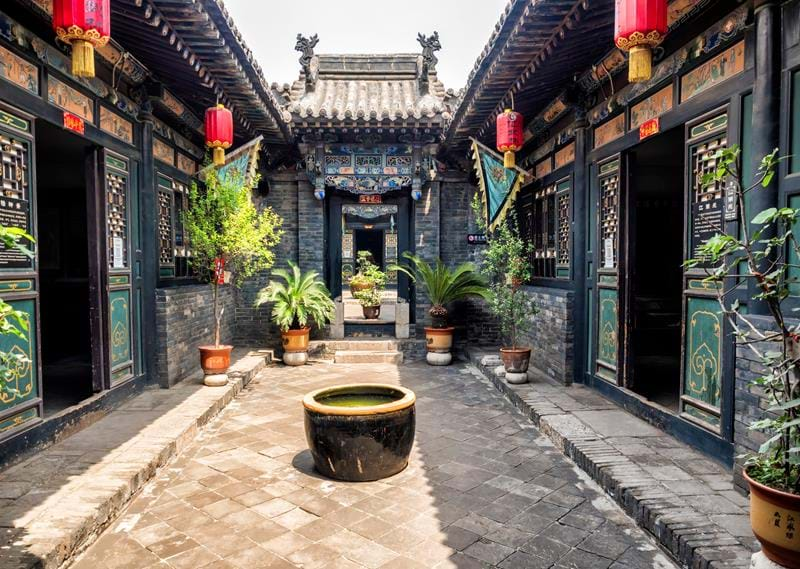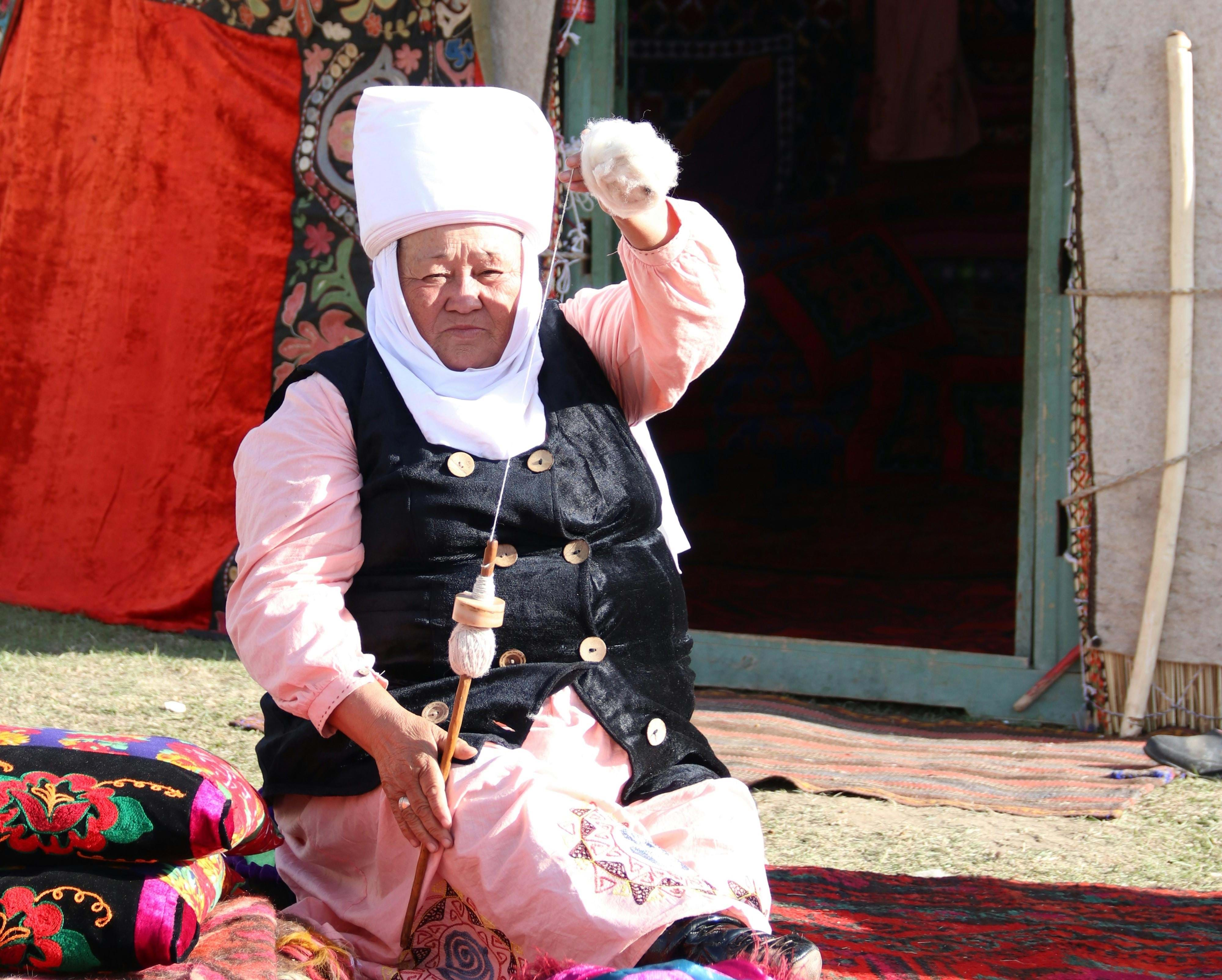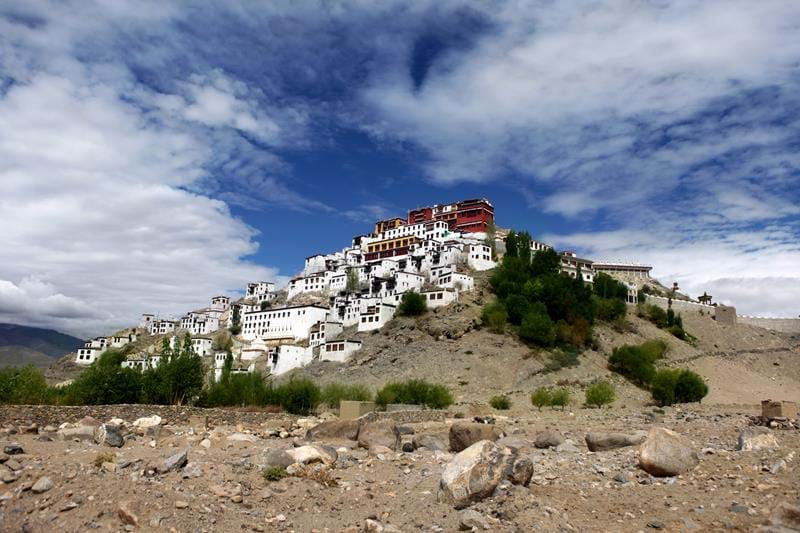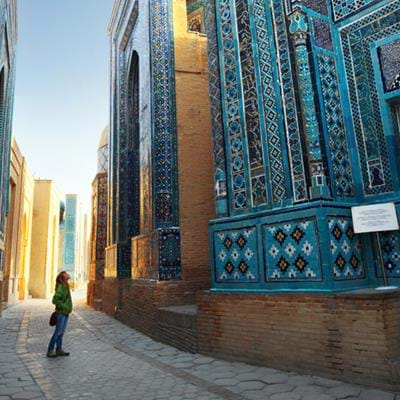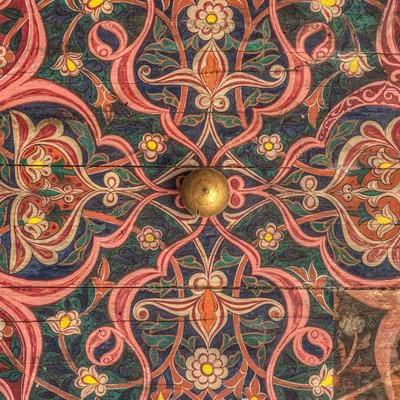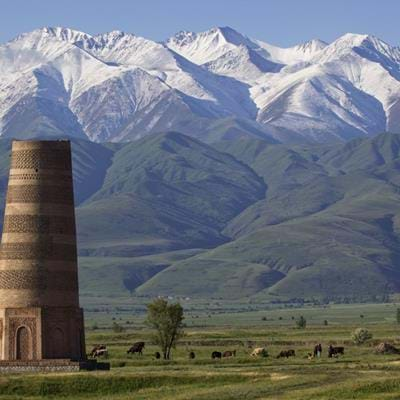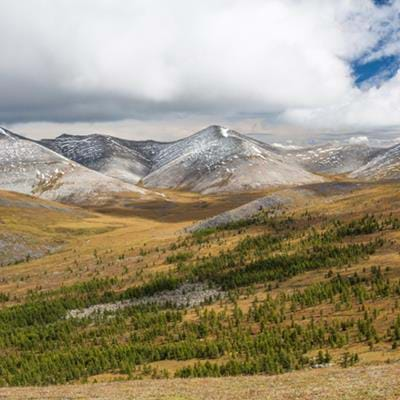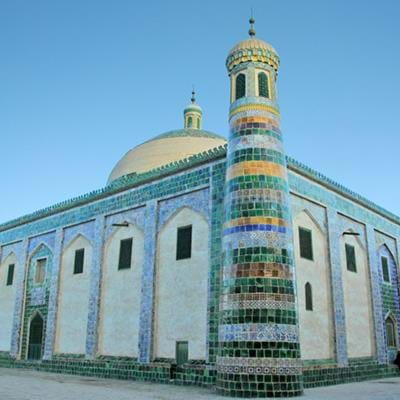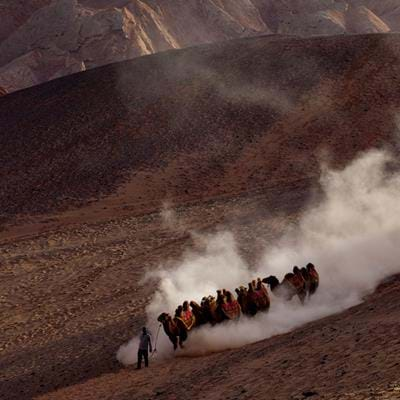Kyrgyzstan 26.01.2024 Transindus
By any account, The Ancient Silk Route, a network of trade routes spanning some 8000 miles connecting disparate places like Geounjgu in the Far East to Constantinople and Venice in the West, from Chang'an (Xian) in the North to Leh in the South, across thousands of miles of scorching deserts, treacherous mountain passes and mile after mile of unending grasslands, laden with precious goods from spices, herbs, exotic fruits, gemstones, and, of course, the prized fabric for which the Silk Road got its name, is a monumental tribute to the spirit of man.
The very idea of it conjures an image of excitement and imminent danger in pursuing one's goals. Unsurprisingly, the route beckoned as many adventurers, artisans, poets, artists, academics, and philosophers as traders to join the caravans in pursuit of their passion. It is probably the same reason why today's adventurous continue to be fascinated by it.
Great Caravansaries emerged along the way at regular intervals for resting overnight, with some evolving into grand bazaars and magnificent great cities, leaving behind spectacular architecture, monuments, and monasteries as compelling legacies for today's visitors to experience.
Here are some of our favourite sites from across the length and breadth of the Silk Road, showcasing the spectacular diversity of the Ancient Trade Route.
Check out a few of the captivating experiences and tours here.
Xi'an Shannxi Province, China
When speaking of The Ancient Silk Road, you have to begin with Xi’an (formerly Chang’an), the ancient imperial capital of the Qin Dynasty, China’s first unified Empire and long considered the eastern departure point of the Silk Road – an absolute must for anyone keen on exploring the Silk Road!
When the Han succeeded, the Qin greatly expanded their territories and the city of Xi’an, establishing it as a political, economic, and cultural governance centre and building the Xi’an City Wall as a vital defence. Around 138 BC, Emperor Wu Di of the Han famously despatched missions in 138 BC to southeast Asia, central Asia and eventually even Rome, marking the beginnings of the Silk Road.
Around the 1st century BC, Buddhism travelled along the trade route and arrived in China, and with both Institutional and imperial support, powers flourished through the region. Xi’an was established as a centre for Buddhist teachings, and vast monasteries were built around the city to translate Buddhist texts and teachings. Many of these monasteries survive and are well worth a visit, including the Giant Gooses Pagoda, Daci’em Temple, Famen Temple, the Qinglong Temple and the Pingayao temple, as they provide historical connections to the Silk Road and the cultural significance of Buddhism in the region.
The Great Mosque of Xi’an and the vibrant Muslim Quarter, with its bustling market streets, traditional architecture, and stalls serving delicious street food, reflect Xi'an's historical role as a multicultural hub along the Silk Road and its rich Islamic heritage. Last, The Shaanxi History Museum, housing a vast collection of artefacts and relics, including those related to the Silk Road, sheds light on Xi'an's role as a cultural and economic centre along the Silk Road.
Check out our tour covering Xi'an: China's Ancient Heartland: - 15 day tour from £4745 pp
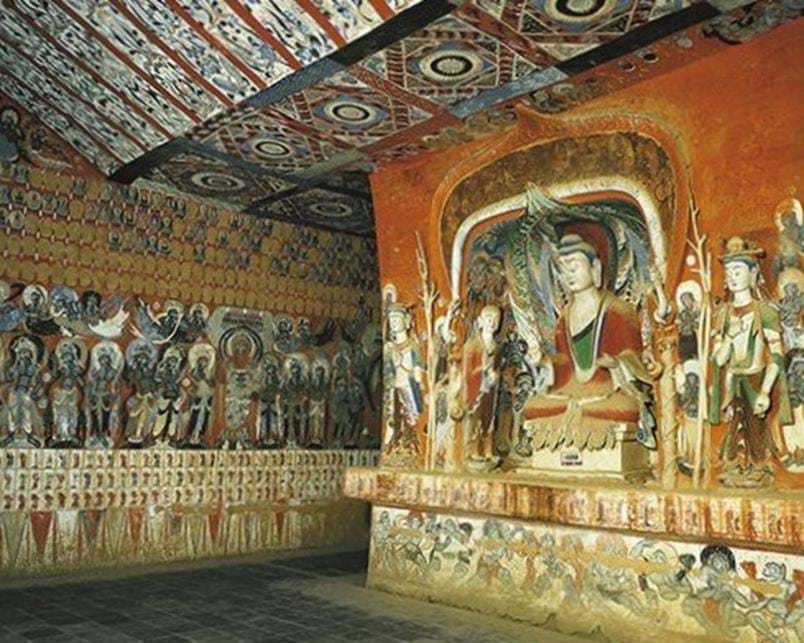 Photo courtesy of Chinaculture.org
Photo courtesy of Chinaculture.org
Outstanding Art of the Magao Caves,
Gansu Province, China
Nothing prepares you for the treasures and history of Magao caves. No books, photographs, or descriptions can capture the detail and lifelike presence of the frescoes, paintings, and art. Travellers over the centuries have reported being transported to other worlds while admiring them.
Standing proud at one of the most easterly and strategic points, where two branches of the Silk Road converge, stand the Magao Caves, a collection of some 1000 caves, also known as the Thousand-Buddha Caves. They were a major centre of Buddhist learning and trade along the Silk Road for over a thousand years. Around the 1300s, during the Mongol invasion, some caves were lost, and others were sealed and covered in murals to conceal. Some 492 caves survived and flourished with a collection of over 4,500 square metres of exquisite murals, 2000 pieces of sculpture and art, including silk paintings and embroidery religious manuscripts and texts unmatched in quality or historical value, encapsulating the spiritual and artistic evolution of the ancient world spanning many centuries and recording the life through the Sui, Tang and Song dynasties of China and civilisations as diverse as Gandhara, India, and Uyghur, linking the East and West of the ancient world.
Relatively recently, in 1900, a resident Buddhist priest discovered a hidden chamber, now famously known as the 'Library cave', a treasure trove of 50,000 documents, drawings and texts, including the Diamond Sutra, the world's oldest books. Soon after, in 1907, a British archaeologist, Sir Aurel Stein, en route to India, heard of the discovery and diverted his journey to Dunhuang, gave the priest four silver pieces and hauled away thousands of manuscripts, silk scrolls and wood slips, including the Diamond Sutra, and sold to the highest bidder, scattering them across the world in various museums and private collections. Despite his actions and those of other French, Dutch and Japanese looters, the Magao collection remains the world's largest and historically most crucial repository of ancient oriental art.
Combine your visit with the nearby and unlikely oasis of the Crescent Lake and Jade Gate, just 80 Km away, at Khotan, once the most prominent and prosperous city of the Xinjiang province, by jealously guarding the trade of its highly prized jade that came rare shades of lavender, green and white.
Check out our tour covering Magao Caves: China's Ancient Silk Road: - 19 day tour, from £7,195 pp
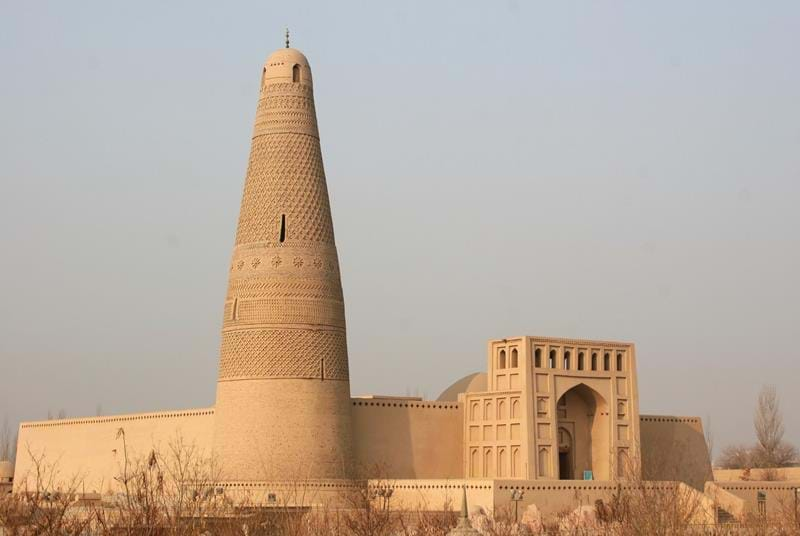
The Timeless Bazaars of Turpan, Xinjiang, China
Sitting on the edge of the Flaming Mountains, the atmospheric Uyghur oasis of Turpan on the northern Silk Road owes its existence to a 3000-mile network of irrigation tunnels and wells, known as Karez, which collect and channel meltwater from nearby mountains. Turpan’s elevation, at 30m below sea level, ensures freezing winters and scorching summers that can reach ground temperatures of up to 70 degrees C.
Thanks to the incredible of the land made possible by Karez channels, Turpan is famous for its lush vineyards and silk weaving as it is for its distinctive Uyghur culture and history. A succession of large, walled cities sprang up here over the centuries, the wonderfully preserved ruins of which can be visited, like the 18th-century architectural marvel of Gaochang and Emin Minaret. Artefacts from the region, including an impressive collection of mummies, are displayed at the town’s excellent museum (the best on the Silk Road), along with a superb array of dinosaur fossils.
Check out our tour covering Turpan: Legends of the Silk Road:- 23 day tour, from £7,595 pp

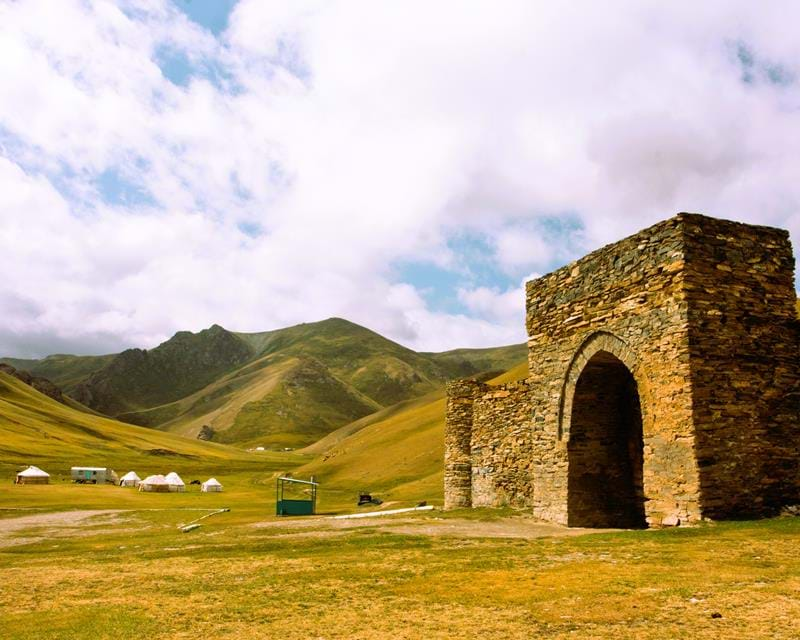
Tash Rabat and Torugart Pass, Kyrgyzstan
Adventurers among you will want to immerse themselves in the rich cultural tapestry of the Torugart Pass, a high mountain pass that runs from Bishkek, Kyrgyzstan, through Naryn to Kashgar, China through breathtaking vistas of the snow-capped Pamir and Tien Shan mountains, stunning lakes of deep blue-green glacial waters and wide-open grasslands dotted with traditional yurt encampments where nomadic herders rear herds of horses, sheep, goats, and yaks.
Whether you Walk, hike, ride or drive through the pass, you can sleep under the stars and stay with nomadic families to experience their exceptional and sustainable way of life. Make sure you visit the Tash Rabat Caravanserai, a historic stone structure dating back to the 15th century, alongside the pass and beckons, with its architectural marvel. Situated at a picturesque crossroad, Tash Rabat served as a resting place for merchants and traders and now allows visitors to peek into their lives, adding depth and richness to the journey through this historic crossroads of civilisations.
Check out our tour of Torugart Pass: Ultimate Silk Road: - 28 day tour, from £7.500 pp
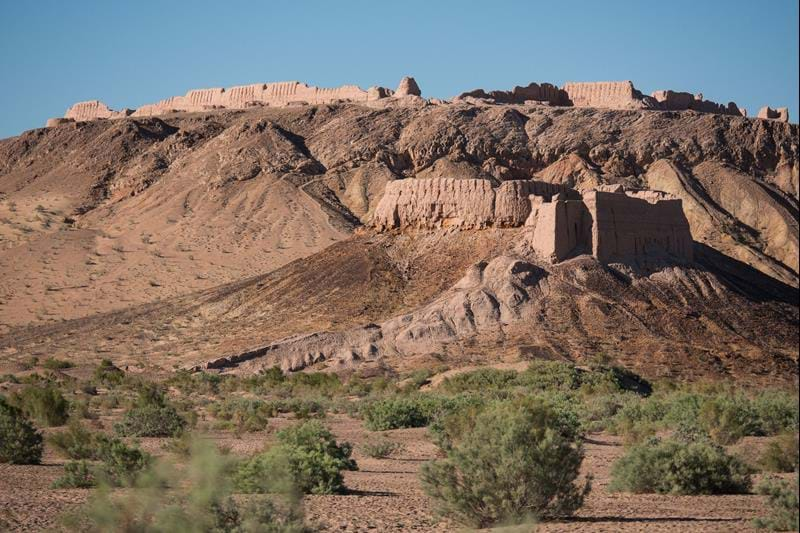
The Desert Forts of Khorezm, Uzbekistan
Just a half-day excursion out of Khiva, on the outskirts of Urgench, sit the fascinating 2000-year-old Citadels of a long-extinct dynasty, marking its celebrated engineering and architectural prowess where life was supported by an ingenious system of irrigation that redirected meltwaters of the Pamir mountains that transformed this arid delta of the Amu Darya (Oxus) into a lush and fertile oasis adorned with lakes, reed beds.
Crafted over two millennia ago, these Mud-Walled citadels fortified the region and protected its prosperity, and although just a few survive today, like the Toprak Kala and Ayaz Kala, in various stages of ruin, they stand as poignant reminders of Khorezm's rise and fall. However, tragedy struck with the 13th-century Mongol invasion led by Genghis Khan. The Khorezmshah dynasty fell, Urgench crumbled, and the forts lost significance.
Check out our tour of Khorezm: Silk Road Explorer: Turkmen & Uzbek - 15 day tour, from £4,995 pp
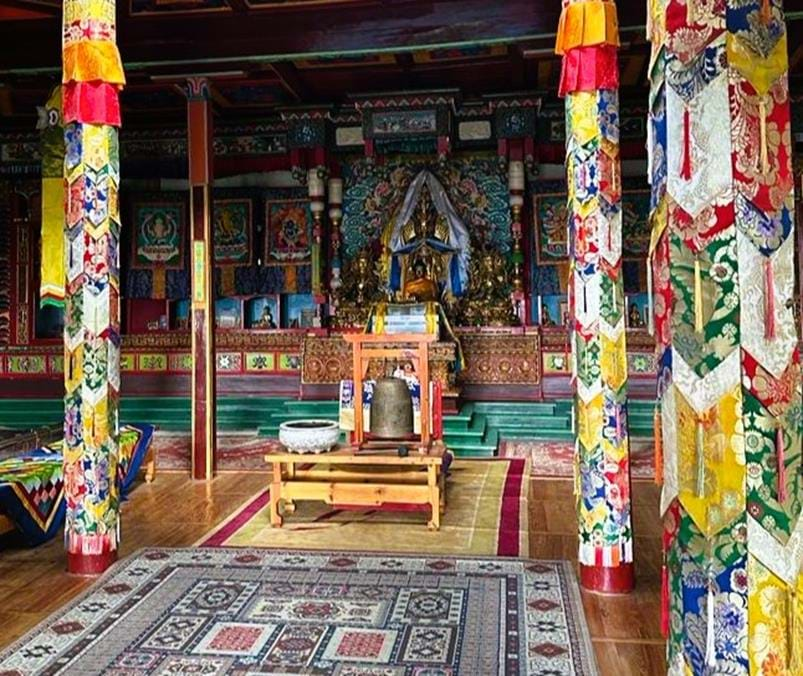
Mongolia and the Silk Road
While most people know the vast Mongol Empire created by Genghis Khan in the 13th century, few know of its much older links to the Ancient Silk Road. Despite its seeming remoteness and cultural differences, Mongolia has links with the ancient trade back to the first millennium BC.
Pristine wilderness and landscapes, a vibrant culture, and nomadic encampments are the preeminent attractions of Mongolia, a country four times the size of France. Mongolia stretches far and wide across the Steppes, the Gobi desert, and the Taiga, where life has remained unchanged from their ancestors' times.
Culture vultures need not worry; some incredible remnants of Mongolia’s past reflecting its long and illustrious history still survive and can be visited, including the Deer Stones, ancient megaliths dating back to the Bronze Age with intricately carved motifs believed to have had ritualistic significance. The 6th century UNESCO World Heritage Burial mounds and stone monuments of the Orkhon Valley, the stunning Erdene Zuu Monastery, Mongolia's oldest Buddhist monastery, standing on the ruins of Karakorum, the ancient capital of the Mongol Empire and the Takhiin Tal, an archaeological site in northern Mongolia contains rock carvings and petroglyphs dating back to the Bronze Age, depicting scenes of hunting, wildlife, and daily life.
Check out our tours covering Mongolia: Northern Exposure: - 15 day tour, from £5,275 pp
Leh, Ladakh, India
Ladakh, nestled in the northernmost reaches of India, shares profound historical connections with the Silk Road and the Karakoram Highway, traversing Pakistan and China at a pivotal junction for trade and cultural exchange between the Indus Valley and Central Asia.
Despite its relatively small size, Leh emerged as a bustling centre of great significance on the Silk Route, where merchants from diverse regions converged to exchange commodities and ideas, each leaving their mark on the small town. With echoes of Bhutan, Tibet, and China, Leh offers unique insights into the cultures of surrounding mountain Kingdoms that remain challenging for visitors.
The Grand Palace and Stok Monastery stand majestic aloft on a mountain at the heart of Leh, echoing tales of its splendour and offering splendid panoramic views of the surrounding landscape. Other similar grand and majestic monasteries and Palaces lie dotted in surrounding valleys, each of which once provided shelter, respite, and spiritual solace for weary travellers, including the beautiful Shey Monastery and Palace. The Alchi Monastery, covered in beautiful frescoes and intricate woodwork, and Diskit Monastery, perched in the picturesque Nubra Valley, should not be missed.
Check out our tours covering Ladakh: Little Tibet - Ladakh in Style: - 14 day tour, from £4,535 pp
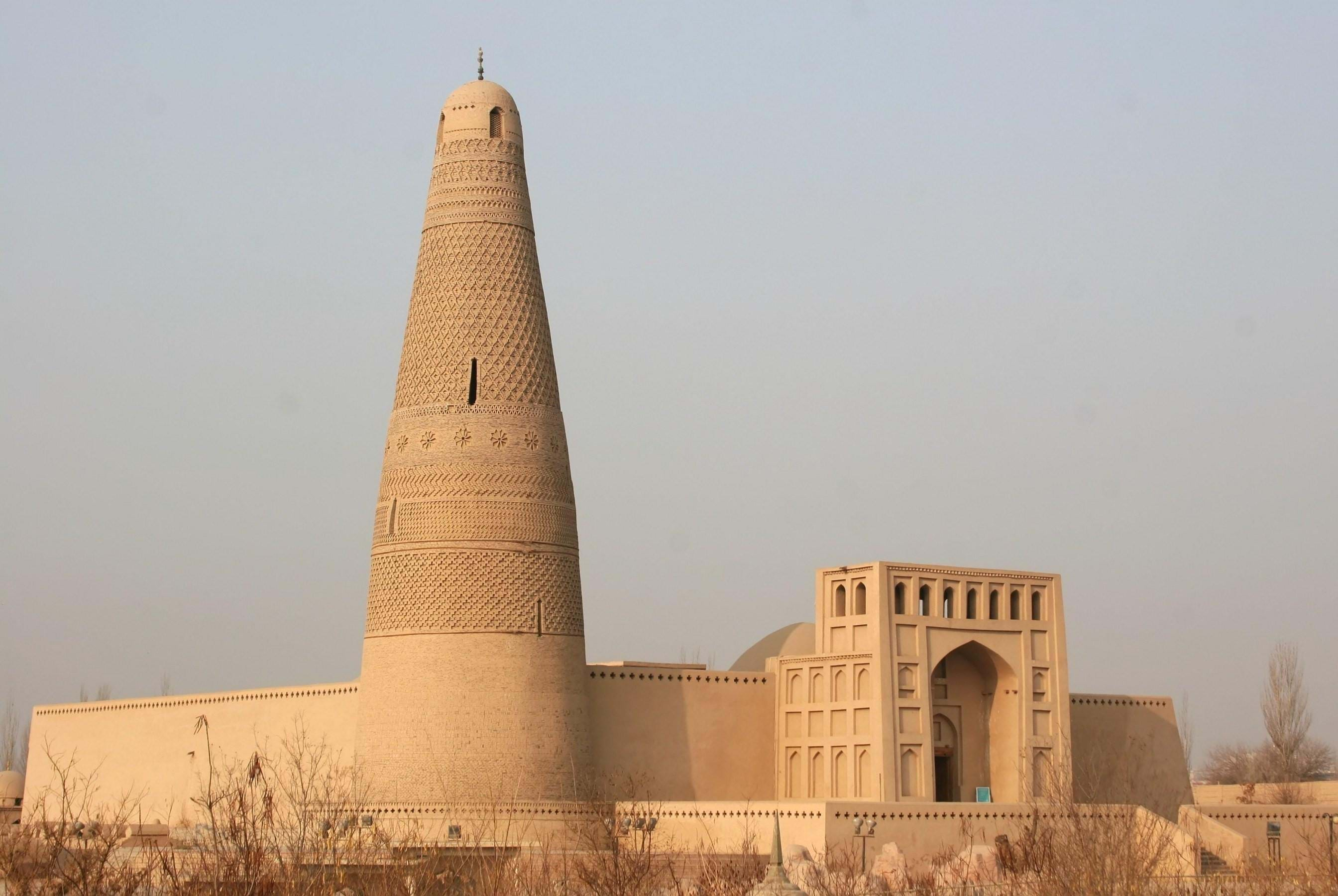
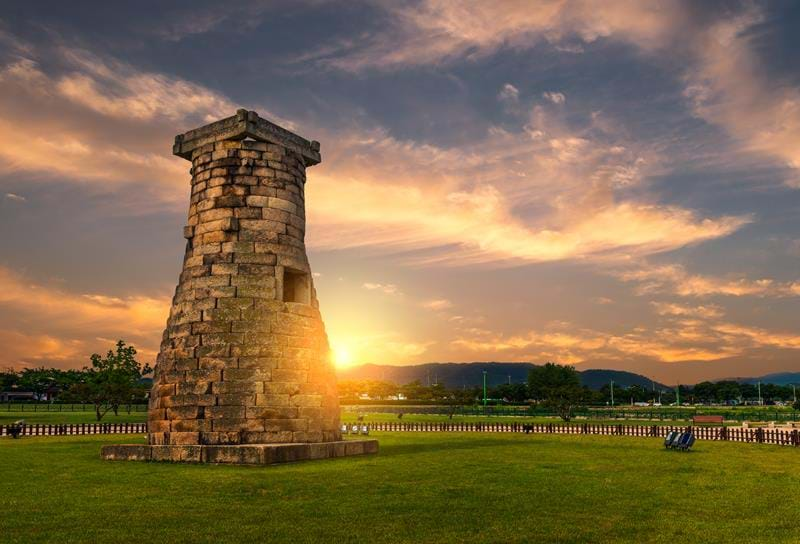 Gyeongju, South Korea
Gyeongju, South Korea
Gyeongju, often dubbed the "Museum Without Walls," boasts a significant tie to the Silk Road as a bustling centre for trade, cultural exchange, and idea dissemination in ancient times. Its land and maritime routes with China and Japan facilitated interactions with Silk Road civilizations. Indeed, there is clear evidence of direct trade via sea routes and settlers from south Asia arriving in the 11th century, including an Indian princess from Ayodhya who went on to become Queen Heo Hwang-ok, the consort of King Kim Suro of the Karak Dynasty.
The history of Gyeongju is intertwined with the Silk Road. You can see its heritage in sites like the UNESCO-listed Bulguksa Temple, which exemplifies Korean Buddhist architecture influenced by the Silk Road's transmission of ideas from India to East Asia. Nearby is the Seokguram Grotto, with one of the world's most beautiful Buddha statues carved in glistening granite, embodying the impact of Buddhism on Korean culture.
The Cheomseongdae Observatory, dating to the 7th century, symbolizes the scientific and cultural exchanges of the Silla Dynasty era, while the National Museum showcases artefacts of the period, including pottery, jewellery, and Buddhist relics influenced by the Silk Road trade.
Scattered across Gyeongju are the Royal Tombs of the Silla Dynasty, offering insights into royal customs and the kingdom's prosperity fuelled by maritime trade routes linked to the Silk Road. In essence, Gyeongju's historical sites epitomize Korea's connectivity with the Silk Road, underscoring its broader engagement with East Asian civilizations.
Check out our tour of Gyeongju: Highlights of South Korea: - 8 day Group tour, from £1,795 pp
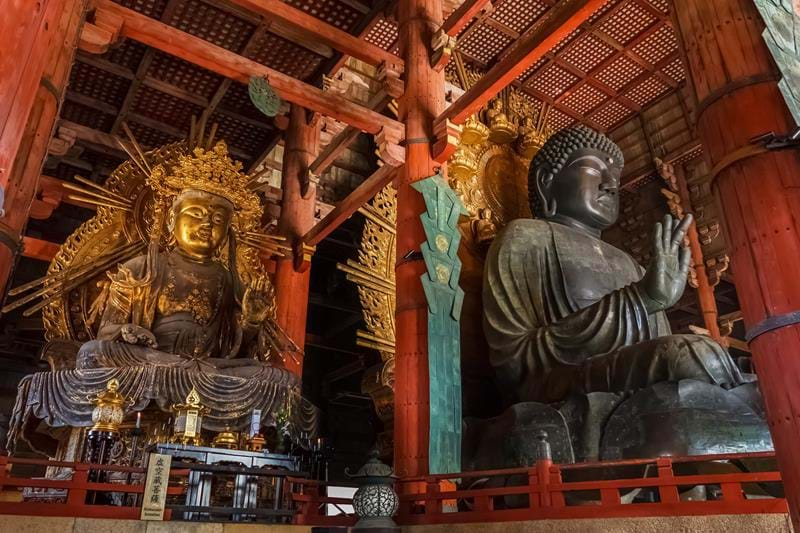
Nara, Japan
Finally, while Japan wasn't directly a part of the Silk Road under geographical isolation as an archipelago just off the coast of eastern Asia, Buddhism nevertheless reached Japan via Korea in the mid-6th century AD, when King Seong of Baekje, a kingdom of Korea sent a delegation led by the monk Eji to Japan in the 6th century. The Buddhist philosophy spread quickly, establishing itself as a state religion.
Nara later became a centre of Buddhist culture. She served as a conduit for exchanging goods, ideas, and religion, maintaining significant ties to the Silk Road and serving.
and because it went through a period of self-imposed isolation, Nara flourished as a conduit for the exchange of goods, ideas, and religious maintaining significant ties to the Silk Road, serving as a cultural and intellectual hub during the Nara Period (710-794 AD).
Visitors today can explore sites that echo its Silk Road connections in the city’s renowned Todai-ji Temple, home to the Great Buddha Hall (Daibutsuden), housing a colossal bronze Buddha statue. Funded by Emperor Shōmu, its construction aimed to propagate Buddhism and foster international relations, illustrating Nara's engagement with Silk Road cultures. Its National Museum displays an extensive collection of Buddhist sculptures, paintings, and artefacts, reflecting the artistic and cultural exchanges facilitated by the Silk Road.
Nearby Horyu-ji Temple, one of Japan's oldest, showcases Buddhist relics and artefacts, highlighting Silk Road aesthetics and iconography in its architecture and art. At the same time, the Yakushi-ji Temple, dedicated to the Medicine Buddha, features exquisite Buddhist sculptures and architecture reflecting the cosmopolitan influences of the Silk Road period. Naramachi, Nara's historic merchant district, provides a glimpse into the city's commercial and cultural exchanges during the Silk Road period. Visitors explore traditional machiya (townhouses), shops, and museums, showcasing Nara's history as a trade and commerce hub, underscoring its historical ties with the trade route.
Check out our tour of Nara: Sacred Trails of Japan: - 15 day tour of Japan, from £5.500 pp
